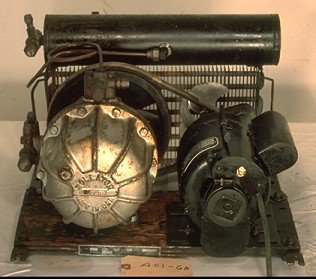Refrigerating and Air Conditioning Condensing Units – Household
A “high tech” refrigerating machine of the mid 1930’s, the “Norge Rollator” was a precursor of profound change in the technology offerings of the Canadian refrigeration industry. By making use of the best engineering knowledge of the times, this innovative machine both responded to public desire for a less crude mechanical monster in the kitchens of the nation, and at the same time built further expectations for what was to soon come. It was a whole new design concept, by a new generation of world class engineering companies who had entered the now rapidly expanding North American home appliance market, the Borg Warner Corporation of Sweden, Norge Division, Borg-Warner Corp. Detroit Mich, 1935.
Technical Significance:
It was a whole new design concept, by a new generation of world class engineering companies who had entered the rapidly expanding North American home appliance market, the Borg Warner Corporation of Sweden, Norge Division, Borg-Warner Corp. Detroit Mich, 1945.What was signalled here was the end of the refrigeration condensing unit as a mere assemblage by mere assemblers of parts based, variously, on a range of buy- make decisions appropriate for the market conditions of the moment [See for example #033].The commitment of the industry would be increasingly to specialised compressor design and to smoothly integrated systems applying state of the art systems thinking [See for example #036.
Industrial Significance:
Of significance in the Canadian industrial context is the Rogers connection with leading edge innovations in the refrigeration field. Toronto based Rogers-Majestic, by 1928, was the largest manufacturers of radio broadcast receivers in Canada, enjoying the market boom of the times. The Rogers empire was founded on innovative the work of Edward S. Rogers, who received a Dominion of Canada patent for a “rectifying system” on June 16, 1925. By August of that year Rogers was in mass production of the worlds first practical AC radio tube and the first Rogers Batteryless radio broadcast receiver.
By the early 1930’s the company was looking to expand and consolidate its reputation for technological innovation and market leader. Rogers acquired the rights to Norge name in the early to mid 1930’s to further establish themselves as Canadian leaders in the rapidly growing field of household, consumer technology [See advertisement in “Radio Trade Builder”, March 1935]
This international partnership arrangement would also represent a model for much of what was to come. Much in the Canadian HVACR industry would come as a consequence of corporate arrangements of convenience between Canadian and international manufacturers and suppliers to the Canadian HVACR field.


